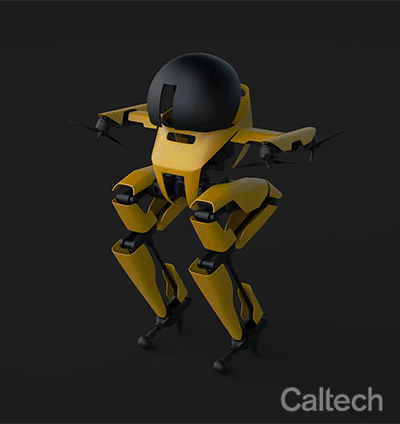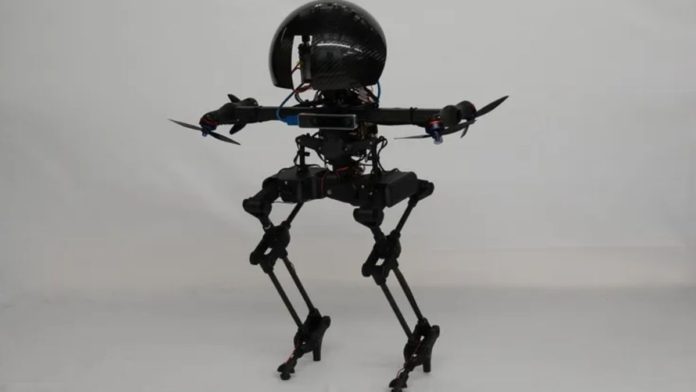Caltech researchers have created a bipedal robot that combines walking and flying to produce a new style of locomotion that allows it to be extremely agile and perform complicated motions. Dubbed Leonardo, is a bipedal robot with a thruster that allows it to balance well and move quickly.
The project’s goal is to look at the confluence of walking and flying from the standpoints of dynamics and control, in order to “offer unparalleled walking capabilities and address the difficulties posed by hybrid motion,” as the project’s engineers put it.
LEO can undertake a wide range of robotic activities, including high-voltage line inspection and monitoring of high bridges, thanks to its combination of walking and flying abilities.
Weighing just 2.58 kg and 0.75 meters tall, LEO is primarily made of carbon fiber. It’s very light, allowing its drone-like thrusters to lift the robot off the ground. It can walk on a slackline, hop on a trampoline, and even skateboard. LEO is the first robot to accomplish precise balance control through the use of multi-joint legs and propeller-based thrusters.
LEO consumes 544 watts while walking on the ground, with 445 watts going to the propellers and 99 watts going to the electronics and legs. LEO’s power usage nearly doubles while flying, but it’s obviously a lot faster—the robot has a cost of transport (a measure of self-movement efficiency) of 108 when walking at 20 cm/s, decreasing to 15.5 when flying at 3 m/s.
This version of LEO differs substantially from the one we originally met two years ago. Most significantly, instead of “LEg ON Aerial Robotic DrOne,” “Leonardo” now stands for “LEgs ONboARD drOne.”

The redesigned LEO now has considerably lighter weight legs operated by lightweight servo motors, allowing it to fly. Two coaxial propellers have been replaced with four slanted propellers, allowing for attitude control in all directions. The four propellers of LEO’s tilting electric thrusters are timed to allow LEO to make jumps. And everything, including computers, batteries, and a new software stack, is now onboard, which implies no complicated wiring and full autonomy.
According to Caltech, LEO is still a prototype—a kind of proof-of-concept to determine if a bipedal flying robot can execute tasks that would be difficult or impossible for ground robots or aerial drones to do on their own. Researchers envision that the full-fledged version of the robot might be entrusted with tough or risky tasks in the foreseeable future, such as inspecting and repairing damaged infrastructure, installing new equipment in difficult-to-reach locations, and responding to natural catastrophes and industrial accidents. A robot similar to LEO may eventually deliver sensitive equipment to the surface of a celestial planet like Mars or Saturn’s moon Titan. On the grim side, the agile bipedal flyer might be employed for protection or warfare.
The Caltech team also hopes to develop adaptable landing gear for VTOLs (vertical take-off and landing) on challenging terrain. Researchers are already considering methods to improve LEO’s energy efficiency by redesigning the legs so that it relies less on the propellers for balance while walking. The team is also focusing on making it more self-aware so that it can analyze its surroundings and choose the best course of action. Further, they are working on improving the performance of the LEO by creating a stiffer spindle design capable of supporting more robot weight and increasing propeller thrust.
Read More: Xiaomi Launches new open source Quadruped robot CyberDog
Soon-Jo Chung, the corresponding author of the paper published this week in the journal Science Robotics, noted in a statement, “We drew inspiration from nature.” “A complex yet intriguing behavior happens as birds move between walking and flying,” said Chung, who is also Bren Professor of Aerospace and Control and Dynamical Systems.
Chung explains that the manner in which a human in a jet suit controls their legs and feet when landing or taking off is comparable to how LEO employs synchronized control of distributed propeller-based thrusters and leg joints. From a dynamics and control aspect, the Caltech team wanted to investigate the interface between walking and flying.
Biped robots can navigate complex, real-world terrain using the same actions as humans, such as jumping, jogging, and even climbing stairs, although rough terrain hinders them. Flying robots can easily navigate rough terrain by avoiding contact with the ground, but they have their own set of limitations, including high energy consumption in flight and a limited payload. LEO proposes to close the gap between the two distinct realms of air and pedestrian navigation, which are rarely combined in present robotic systems.


